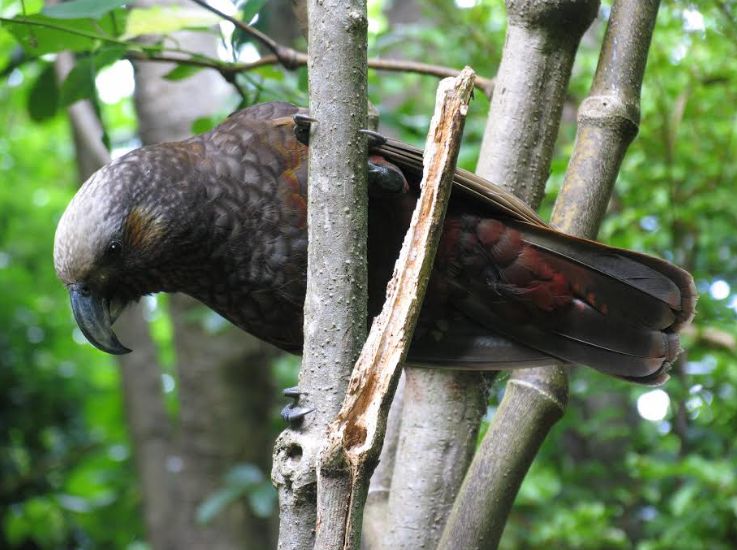Sex Balance Revealed Among Pureora Kākā

Credit:
Herb Christophers/DOC / Supplied
New research into the kākā population in Pureora Forest shows a 50:50 sex ratio for the first time – a result credited to successful predator control.
Kākā are rowdy and sociable parrots found in New Zealand’s native forests. Stoats and possums are the key threat to kākā, with females and chicks the prime targets during nesting when they stay in tree cavities for long periods. Over time, this leads to a male-skewed and declining kākā population.
A group of DOC and other scientists spent a week in the Pureora Forest last October, capturing and releasing kākā. It was a second trip into the Waipapa block to determine the health and gender balance of the local kākā population.
DOC Principal Science Advisor Terry Greene says the previous trip in 2023 had been “puzzling and concerning” because few birds were caught and all were males. However, the latest survey results were exciting.
“We caught an equal number of female and males which is a good sign of a healthy kākā population. This leads to more kākā breeding and chicks produced boosting the Pureora population.
“This is the first time in our monitoring of kākā at different sites we have found a 50-50 gender balance. At sites where there has been no predator control the ratio has been as low as one female to five males.
“With no predator control to protect kākā, females get taken out, breeding declines, old males are left behind – and after a while there are no kākā at all,” he says.
A total of 22 birds were captured (at 14 sites in Waipapa and two sites in Pikiariki) of which 11 were male and 11 were female during the October field work.
Kākā are generally monogamous during breeding season, which is triggered by forest masts – when trees produce and drop their fruit and seeds. Peak egg laying for kākā is December and January, and females sit on the eggs (clutches can be up to five eggs) for about 24 days before hatching.
Terry says the Pureora kākā population is “doing extremely well”, with the birds even obvious around the forest’s village – another indicator of the kākā population success.
“They’re doing as well as kākā on off-shore islands – where there are no predators – and they’ve responded very well to our management,” he says.
Nature in New Zealand is unique and special. Most of it is only found here. It’s different to what you can find anywhere else. Once our species are gone from here, they’re gone from everywhere.


 Taupo District Council: Punarua Exhibition Arrives At Taupō Museum
Taupo District Council: Punarua Exhibition Arrives At Taupō Museum Office of Early Childhood Education: Teachers Are Paying The Price For Lack Of ECE Funding In The Budget
Office of Early Childhood Education: Teachers Are Paying The Price For Lack Of ECE Funding In The Budget Science Media Centre: Teen Dies After Controversial Tackle Game – Expert Reaction
Science Media Centre: Teen Dies After Controversial Tackle Game – Expert Reaction Howard Davis: The Amici Ensemble Provide A Master Class In Françaix, Fauré, & Brahms
Howard Davis: The Amici Ensemble Provide A Master Class In Françaix, Fauré, & Brahms Burnett Foundation Aotearoa: Local HIV Diagnoses In Decline, Challenges To Achieving Elimination Goal
Burnett Foundation Aotearoa: Local HIV Diagnoses In Decline, Challenges To Achieving Elimination Goal NZSO: NZSO Classical Hits Tour From Kerikeri To Blenheim Begins 31 May
NZSO: NZSO Classical Hits Tour From Kerikeri To Blenheim Begins 31 May